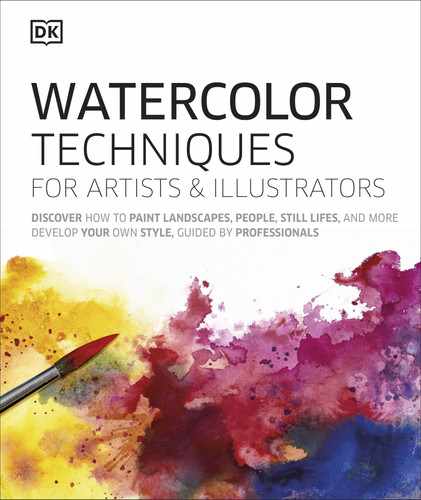
150 Advanced | TECHNIQUES
PUTTING IT INTO PRACTICE
The tracks across the snowy eld are represented
here in a few blue washes. Rather than trying to
paint around the highlighted snow furrows, opaque
shapes are added on top of the watercolor wash.
2
Foreground snow
It is important to
apply all the snow as
one continuous wash,
only leaving a few
highlights and breaks to
show the white paper,
to enable a comparison
with the gouache at a
later stage. Allow sky
and background to
merge wet-in-wet.
1
Base washes
Establish the main
composition with a light
pencil sketch. Start with
a sky wash of cerulean
blue and while still wet,
paint simple shapes for
the background trees
with bold, transparent
mixes of French
ultramarine and alizarin
crimson, adding burnt
sienna to the left.
Dening edges
Painting around intricate light
shapes in watercolor makes it
difcult to create crisp edges.
Apply gouache over a wash to
paint in detailed shapes and
retain a dened edge.
Adding highlights
It can be difcult to leave
shapes in white paper for small
highlights. Use gouache, either
as a pure white or mixed with
a wash to create an opaque
light that gives added
dimension to the shape.
1 in (25 mm) synthetic at brush
No. 12 and no. 8 soft-hair
round brushes
11 x 15 in (28 x 38 cm)
cold press 140 lb (300 gsm)
watercolor paper
You will need
Cerulean blue
Alizarin
crimson
French
ultramarine
Raw sienna
Cadmium red
White
gouache
Cobalt blue
Burnt sienna
Tire tracks in snow
Using gouache
ADDING OPACITY TO COLORS AND HIGHLIGHTS
Including gouache paints in your palette will
extend your range of techniques. Opaque
effects add contrast to transparent washes,
with the opportunity to add light over dark
in any color. Any subject with white or light
components is suitable, from snowy scenes
to falling water or breaking waves.
Enhancing light-colored shapes
Remembering to leave clean, white shapes in the
paper for highlights and lights can be slow and clumsy,
interrupting the ow of a wash and perhaps losing
edges. Instead, use gouache to paint light-colored
areas on top of a watercolor wash, giving you more
control of your marks and to add dened lights.
Using white gouache can be
easier than painting around
small spaces
Uneven edges in watercolor
Dened edges in gouache
US_150-151_Adding_Gouache_Techn.indd 150 02/04/2020 3:34pm

151 Using gouache
3
Blue shadows
Mix a range of blues for the dark shadows.
Apply simple strokes in different brush sizes,
using cobalt for the mid ground and transition
to a warmer tone darkened with red.
4
Warm contrasts
Darken blue washes with red, burnt
sienna, and some alizarin crimson, letting the
warmer tones blend in the trees. Add dashes
of the shadow colors for the tire treads.
5
Opaque texture
Use dry brush marks in pure gouache with
little water added to highlight the edges of the
furrows against the blue shadows. Contrasts
with the white paper add textural interest.
US_150-151_Adding_Gouache_Techn.indd 151 02/04/2020 3:34pm
..................Content has been hidden....................
You can't read the all page of ebook, please click here login for view all page.
